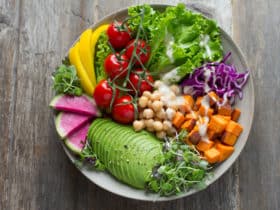The vegan market has been exponentially increasing over the past 10 years, making more people each year turn to plant-based diets. Each person has different reasons for going vegan; some may do it for health reasons, help prevent climate change, or save animals.
Regardless of the reason people have chosen for going for eating plant-based food, it can be safely assumed that this way of life is not going away in the near future. In fact, the vegan population is likely to keep increasing as the years pass.
Due to more people going for a vegan lifestyle, businesses around the world have chosen to adapt their business model for the vegan society, which results in the general market exploding with new plant-based food and products. In the case of restaurants, most of them are now including plant-based food in their menus as a way to support this lifestyle.
[BONUS] Infographic
If you’re more of a visual person, we’ve created a nice infographic of the 2021 vegan statistics. Feel free to save it on your computer and share it with others.
It’s important to note that the vegan population has increased, it didn’t happen without reason. If you want to have a deeper insight into vegan and vegetarian lifestyles and their numbers on the world, keep reading for an overview of vegan statistics for 2022!
- What is Veganism?
- Are There Different Types of Veganism?
- Vegan Population in the World
- Vegan Population in the United States
- Vegan Population in the United Kingdom
- Vegan Population in India
- Vegan Population in Other Countries
- Vegan Food Industry and Plant-Based Diets Statistics
- Vegan Sustainability and Environmental Statistics
- Vegan Health Benefits Statistics
- Vegan Celebrities and Trends
- Vegan Fashion Industry
- Vegan Interesting Facts
- Conclusion
What is Veganism?
Before we start going deeper into the vegan statistics, it’s crucial to establish what being a vegan implies. To put it shortly, a vegan person is someone who completely avoids animal products in their daily life; this could be due to health, ethical, or environmental reasons. To cover for the lack of animal protein, vegans go for a “Vegan Diet,” which implies plant-based food, such as vegetables, whole grains, seeds, nuts, fruits, and more.
The word “Vegan” came in 1944 when Donald Watson co-founded the Vegan Society. At first, the word “Vegan” referred to non-dairy vegetarians, but it was shortly changed to refer to people who avoided animal-based products.
While transitioning to a vegan lifestyle is not hard, you need to know how to do it correctly. Going into a vegan diet without knowing how it works can put you at risk of nutrient deficiencies. However, if it’s done right, you may be looking at a huge range of benefits for you and the world.
Are There Different Types of Veganism?
Yes! Vegans are classified based on the type of vegan food they regularly consume on their diet. Each of these groups of people is still considered vegan; the only thing that changes is the type of vegan food they eat.
Overall, these are the five different types of vegans that you can find right now:
Dietary Vegans
This is the most common type of vegan. Here, the person consumes most plant-based meals available in the world right now. A dietary vegan is the most common choice for people since it allows you to consume a broad selection of dishes.
Low-Fat Vegans
A low-fat vegan generally doesn’t consume high-fat vegan foot. Instead, they choose to go for dishes that mainly include fruits in them.
Raw-Food Vegans
Raw-food vegans tend to consume raw or dried dishes. In exceptional cases, they eat dishes cooked at extremely low temperatures. While this is an uncommon type of vegan, there are still some people who prefer these types of dishes.
Whole-Food Vegans
As the name implies, these vegans tend to consume whole foods, such as fruits, nuts, whole grains, and more.
Junk-Food/Fast-Food Vegans
This kind of vegan consumes heavily processed vegan food. It’s not as healthy as the other options above, but it’s still considered more beneficial than other food choices and animal products on the market right now. This involves eating desserts, vegan meat, fries, frozen food, etc.
Vegan Population in the World
![Vegan Statistics: What You Need to Know in 2022 [Infographic] 28 Vegan Population](https://getvegan.com/wp-content/uploads/2021/02/Vegan-Population-1024x512.jpeg)
According to the Veganuary campaign worldwide, over 560,000 people signed up for this activity, which implies eating vegan throughout January. In 2020, there were approximately 400,000 participants on the Veganuary campaign, which translates to an increase of 160,000 people over the course of a year and adding up to over a million participants in total. (Source).
The exact number of vegans worldwide is still uncertain since this number varies depending on the country. However, it’s estimated that approximately less than one percent-to three percent of the world population is currently vegan. It’s complicated to track the exact number because there are several forms of veganism. On the other hand, some people don’t know how to differentiate between vegan or vegetarian diets, making it even harder to do an estimate.
Considering the percentage of less than one percent-three percent stated above, it can be calculated that the number of vegans around the world up until this year is 78 million (or a bit more); this is because the current global population is approximately 7.8 billion, according to the United Nations.
Vegan Population in the United States
Calculating how many people are vegans in the U.S. hasn’t been easy since several sources have established different vegan statistics for Americans. According to the latest vegan statistics done in 2019, two-to-six percent of the adult American population label themselves as vegan. However, a surprising 39% of the American population doesn’t label themselves as vegan but are actively trying to include plant-based diets in their lives; this was explained in a report made from Food Navigator USA.
Additionally, the sales of plant-based products in the United States were valued at 4.5 billion dollars throughout 2017-2019, which implies an increase of over 30% in sales of plant-based products; this has caused two in three Americans to stop or reduce their daily meat consumption and replace it with plant-based meat or general vegan or vegetarian meals.
While the numbers may seem low, the number of vegans in the U.S. has seen incredible growth over the past 10 years, and these numbers are expected to keep growing in the future.
Vegan Population in the United Kingdom
Considering that the term “Veganism” was first introduced in the United Kingdom, it’s undoubtedly among the countries with the largest number of vegans currently following plant-based diets. According to the Vegan Society, the U.K. was the country most involved in vegan and vegetarian lifestyles in 2019. (Source).
Among the most remarkable facts about the United Kingdom is that this country quadrupled its amount of vegans throughout 2014 and 2019. In 2014, there were approximately 150,000 vegans in this country, which represented about 0.25% of the total population. In 2019, there were reported about 600,000 active vegans, which represented 1.16% of the population. (Source).
While these are the general vegan statistics for the United Kingdom, here are some additional data that may be useful for you:
- Approximately 125,000 individuals inside the United Kingdom participated in Veganuary 2021.
- In the year 2018, the United Kingdom was the country to launch the highest number of vegan products to their markets.
- In 2020, the city of Brighton was considered the most vegan-friendly city, followed by Cardiff, Bristol, and Norwich. (Source).
- The vegan/vegetarian community in the United Kingdom expects to widen the vegan demographics for 2025 and get a quarter of the entire British population to turn vegan. Additionally, they hope to make about half of consumers flexitarians.
Vegan Population in India
India’s case with veganism is interesting since this country is considered one with the highest amount of vegans among the global population; this is because Hinduism and other cultural factors have made most Indians have a relatively low rate of meat consumption.
As of 2020, there were approximately 500 million vegetarians and five million vegans in total, making for one percent of the total population.
Vegan Population in Other Countries
We’ve mentioned some of the most prominent countries in the vegan/vegetarian market. However, there are some other countries that have also started to implement plant-based products, new diet and food options, and other things that have made their global population go vegan.
Here is an overview of some of these other global countries and their most recent statistics:
Australia
Australia was once considered the country with the biggest meat consumption rate globally. However, a report made by Statista has established that the country’s packaged vegan food market reached approximately $215 million by 2020, making it the third fastest-growing vegan market.
Italy
Europe is considered one of the main consumers of plant-based meat since they have reported approximately 39% of plant-based meat or meat substitutes sales over the past years. (Source). Italy has been identified as one of the countries with the most vegan individuals since they make up about eight percent of the population. Additionally, this country has reported the fastest-growing vegetarian population with a 94% increase throughout 2011-2016.
Canada
The interest in veganism in Canada has been continuously increasing over the years. In 2017, the terms “Veganism” and “Plant-Based Diet” were top search trends in the Google Trends Report.
Germany
According to the German Nutrition Society, about one percent of the German population is vegan, although this organization has established that vegan individuals should take dietary supplements since they believe a plant-based diet and a completely meat-free lifestyle cannot provide the adequate supply of some nutrients, such as vitamin B12.
South America
According to a study made by Ingredion, about 90% of the South American population is actively interested in consuming plant-based vegan foods or general vegan diet products; this is due to a desire to eat healthier.
Israel
As of 2015, approximately five percent of Israelis were actively consuming vegan or vegetarian food products, according to Israel21C.
China
China has been an active supporter of plant-based foods for quite some time now. In fact, the Chinese Health Ministry has been encouraging the Chinese population of 1.3 billion people to reduce their meat and dairy consumption by 50% and replace it with vegan food products. (Source).
Vegan Food Industry and Plant-Based Diets Statistics
![Vegan Statistics: What You Need to Know in 2022 [Infographic] 29 Vegan Food](https://getvegan.com/wp-content/uploads/2021/02/Vegan-Food-1024x512.jpeg)
One of the most interesting areas to research when it comes to veganism is food. The vegan diet has been evolving for several years now, and it has now become much more accessible for people interested in transitioning from animal products to vegan food products.
As you may or may not have noticed, the demand for vegan products has increased recently, especially in the Asia Pacific, which became a rising market for flexitarians. For example, the global plant milk market is expected to exceed the $21 billion mark by 2024, with soy milk and coconut milk as the primary sales. (Source). Dairy products have been seeing a decline in sales because they have been replaced with non-dairy milk.
Non-dairy milk’s consumption rate in the U.S. has increased by 61%, whereas the consumption of regular milk has decreased by an outstanding 22%. As of today, you can find non-dairy milk ranging from soy milk to almond milk with oats, peas, coconut, and more.
Fast Food and Plant-Based Meat
Eating meat is among of the primary reasons why some people don’t fully transition into the world of veganism. However, many vegans have come up with ways to create types of “Vegan Meat,” which serves as healthy meat substitutes for meat-eaters. According to the Allied Market Research, the meat-free options and overall meat vegan food market is expected to reach a value of $7.5 million by 2025, with “Beyond Meat” as a primary provider of meat-free food options for many people.
It’s important to note that an area where vegan foods excel is in fast-food restaurants. Many meat-eaters opt for these kinds of restaurants to eat meat regularly. However, veganism and its food trend have caused some of these restaurants to include some healthier options for those people who eat meat but don’t want to feel like they’re abandoning it altogether.
On the other hand, the increasing popularity of the veganism market has caused several people to open up new vegan fast-food restaurants, such as Plant Power Fast Food, Monty’s Good Burger, or Veggie Grill. The owner of Plant Power Fast Food has stated that the success of his restaurant is because of all the people wanting to try veganism or vegetarian lifestyles with vegan fast food. (Source).
Popular fast-food chains, such as Pizza Hut or McDonald’s have been testing plant-based options as a meat replacement in their menus, which can bring many positive health changes and help against global climate change.
Overall, the market for non-dairy products and other vegan/vegetarian options is expanding much more, so people currently have a much more comprehensive eating selection regardless of their current eating preferences. In the case of people who want to turn to veganism, the current plant-based foods market has several new options for them to eat.
Vegan Sustainability and Environmental Statistics
![Vegan Statistics: What You Need to Know in 2022 [Infographic] 30 Vegan sustainability](https://getvegan.com/wp-content/uploads/2021/02/Vegan-sustainability-1024x512.jpeg)
The veganism movement is likely to increase even more among the global population, and the main reason for that is because it’s a highly sustainable option. Overall, there are many plant-based eating alternatives that require fewer resources than eating regular meat, dairy, or animal products in general.
According to a study made by Oxford University in 2018, the best way to reduce environmental hazards is to avoid animal agriculture and animal products as much as possible. Overall, 83% of farmland is for animals raised for the purpose of providing meat and dairy. However, these animals that provide dairy and meat only account for 37% of protein consumption and 18% of calories.
Overall, several reports, documentaries, and statistics made throughout past years have thoroughly explained the dangers of animal agriculture due to greenhouse gas emissions, the global benefits of switching to eating vegan foods, and how veganism can positively increase the chances of environmental sustainability in the future.
Here is an overview of some other popular data regarding vegan sustainability and animal agriculture:
- Agriculture is responsible for up to 90% of American water consumption. From that 90%, approximately half of it is used to feed livestock raised to serve as meat or dairy for humans. (Source).
- Animal agriculture is the main responsible for about 18% of global greenhouse gas emissions, which is a much higher amount than all transport emissions combined.
- According to statistics, livestock is a significant cause of climate change, and they cover approximately 45% of global land. (Source).
Vegan Health Benefits Statistics
![Vegan Statistics: What You Need to Know in 2022 [Infographic] 31 Vegan health](https://getvegan.com/wp-content/uploads/2021/02/Vegan-health-1024x512.jpeg)
Many statistics and global reports have continually stated that turning to a vegan or vegetarian plant-based diet can result in an increase in health benefits for the person. Each year, new people get rid of animal dairy and meat products to switch to a plant-based alternative due to their many positive health effects.
Overall, here are the major positive health consequences of following a plant-based diet:
- According to statistics, there are more positive health outcomes from turning to plant-based foods than drawbacks.
- The Harvard T.H. Chan School of Public Health showed statistics that reflected the positive impact of eating non-dairy and vegan foods in diabetic individuals. Overall, eating plant-based foods can reduce the risk of type two diabetes by even a third (up to 20%).
- Switching out from meat or dairy items can also reduce the risk of prostate cancer by 35%. (Source).
Vegan Celebrities and Trends
Each year, new celebrities worldwide reveal that they’re vegan and that they’ve been following a plant-based diet for years; this has caused vegan product sales to increase to even higher amounts since the celebrities’ fans are now more likely to eat those plant-based meals and follow a new, healthy diet.
Some vegan celebrities include Joaquin Phoenix, Paul McCartney, Miley Cyrus, Natalie Portman, Beyonce, etc. Additionally, many professional athletes have stated that they strictly follow a plant-based diet for getting stronger, which has also boosted vegan product sales.
Overall, there are many celebrities that have turned to a vegan lifestyle, and that can help the vegan movement by a high degree since it increases the chances of more individuals following a plant-based diet in the near future.
Vegan Fashion Industry
![Vegan Statistics: What You Need to Know in 2022 [Infographic] 32 Vegan fashion](https://getvegan.com/wp-content/uploads/2021/02/Vegan-fashion-1024x512.jpeg)
Fashion has also played a big part in getting everyone to follow a plant-based diet. Statistics show that 82% of vegan items launched in the U.K. in 2019 were for the fashion and beauty area. When it comes to vegan items, the beauty category makes up a significant 66% of these items in the U.S. and 69% in the U.K. (Source).
Vegan beauty items refer to items that weren’t prepared with any kind of animal ingredients. In that sense, many vegan campaigns work hard to encourage popular brands to stop manufacturing animal products, such as fur, leather, and more.
Thankfully, the increase of vegan individuals in the world has caused some of these brands to “Go Vegan” and change their product lineup almost completely. On the other hand, some other manufacturers have opted for creating safer alternatives to these animal items without harming any living being. For example, Stella McCartney is a popular fashion designer who is known for creating “Vegan Fur and Leather,” which looks almost identical to its original counterpart.
This proves that fashion designers are still able to replace these ingredients without jeopardizing their original product.
> Read more: The rise of vegan fashion in numbers.
Vegan Interesting Facts
Here’s an additional overview of some interesting facts and statistics regarding veganism that you probably didn’t know:
- According to the Oxford Martin Programme on the Future of Food, a global switch to plant-based foods could save up to eight million lives by the year 2025 and produce savings of up to $1,000 billion per year on healthcare.
- The benefit of reduced greenhouse gas emissions could increase to $570 billion in savings if everyone changed to plant-based foods.
- More than 150 billion animals are slaughtered every year for food, and according to statistics and calculations, each vegan can save the lives of up to 30 animals per month, translating to approximately 198 per year approximately.
Conclusion
As you can see, veganism is becoming an even bigger movement each year. More individuals are making the decision to switch to plant-based diets, which can significantly improve a person’s health, save living beings, and help with climate change.
Making the switch is easy; what’s hard is being consistent with it. If you’ve read these statistics and have decided that you want to make the switch to a plant-based diet, make sure to educate yourself as much as possible on what you need to get started!






![Vegan Statistics: What You Need to Know in 2022 [Infographic] 25 Vegan statistics](https://getvegan.com/wp-content/uploads/2021/02/vegan-stats-1600x1199.jpg)



